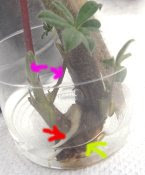USE A BASAL CUTTING
Stems can easily be broken off plants next to busy paths. Found a lupin branch on ground last week. Because it had several basal buds (see bottom left) and some base plate, I placed it in about an inch (2.5 cm) of perlite and water. Never done this before at this time of year (May); it's usually done in early spring; so may or may not work. About a week later, new shoots coming up from basal buds. Wasn't sure if they would or not, as buds could have been dormant. Need keeping in good light now till roots are evident.
About a week later, new shoots coming up from basal buds. Wasn't sure if they would or not, as buds could have been dormant. Need keeping in good light now till roots are evident.NOT ONLY LEAVES CONTAIN CHLOROPHYLL
 Note there are no leaves (normal basal cuttings contain some basal plate complete with buds, stem and two or three leaves) to provide food by photosynthesis to support the growth process. However, there is about 15 cm (6 inches) of green stem - green because it contains the pigment chlorophyll - so this will supply the food. i.e. Green stems (or any green plant tissue) can photosynthesise, as well as leaves. Not everyone understands this.
Note there are no leaves (normal basal cuttings contain some basal plate complete with buds, stem and two or three leaves) to provide food by photosynthesis to support the growth process. However, there is about 15 cm (6 inches) of green stem - green because it contains the pigment chlorophyll - so this will supply the food. i.e. Green stems (or any green plant tissue) can photosynthesise, as well as leaves. Not everyone understands this. I haven't got a photo of the original broken stem. And I don't want to disturb the cutting till it's rooted. So here is the base of another stem, complete with basal bud (marked red) and base plate material (marked pink). It does look rather like a heel cutting, produced when a woody shoot tears away from a shrub or tree.
I haven't got a photo of the original broken stem. And I don't want to disturb the cutting till it's rooted. So here is the base of another stem, complete with basal bud (marked red) and base plate material (marked pink). It does look rather like a heel cutting, produced when a woody shoot tears away from a shrub or tree.ROOTING MATERIAL
Although I have used perlite and water, moist soil or potting compost (either multi-purpose or special potting compost) can be used, especially if perlite or sand is added to aid aeration. I would insert the cutting near the edge (not too near or it will dry out) of the pot, with its bud(s) just beneath the surface; then carefully keep moist (I usually dribble water down the stem, so the base is kept damp after the excess is taken up by the rest of the compost (because it is drier)).
ROOTING STEMS IN WATER
 Many stem bases will also root in water. After leaving base of stem above in a cup or beaker of water (level shown by green arrow) for fift
Many stem bases will also root in water. After leaving base of stem above in a cup or beaker of water (level shown by green arrow) for fift een days, new shoots (pink) and a new root (red) have developed. Water-rooted cuttings can be more brittle than perlite-rooted ones, but young plant can now be carefully transferred to moist soil or compost, so soil is at same level as water. Imperative to keep out of direct sunlight.
een days, new shoots (pink) and a new root (red) have developed. Water-rooted cuttings can be more brittle than perlite-rooted ones, but young plant can now be carefully transferred to moist soil or compost, so soil is at same level as water. Imperative to keep out of direct sunlight.
No comments:
Post a Comment